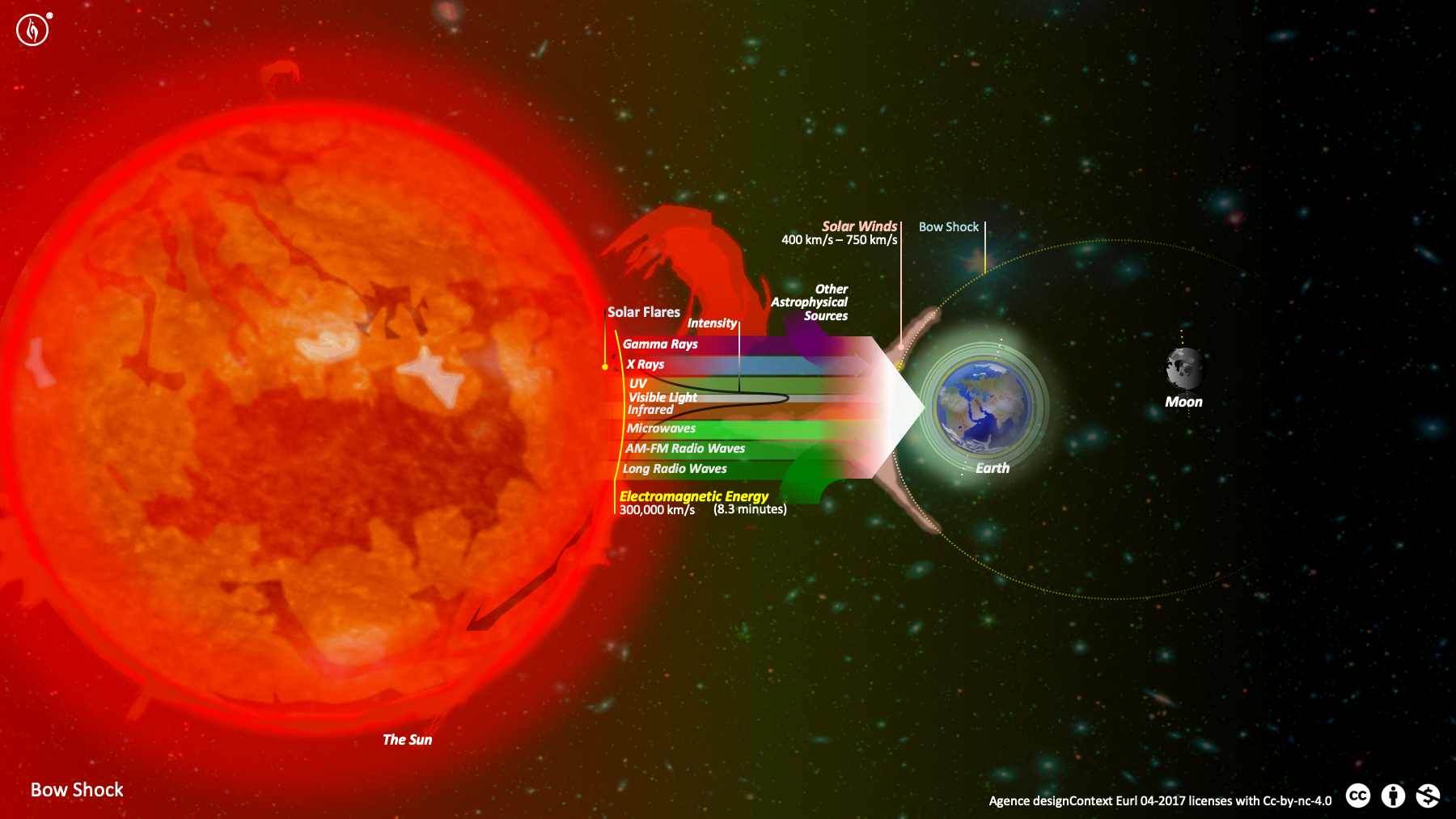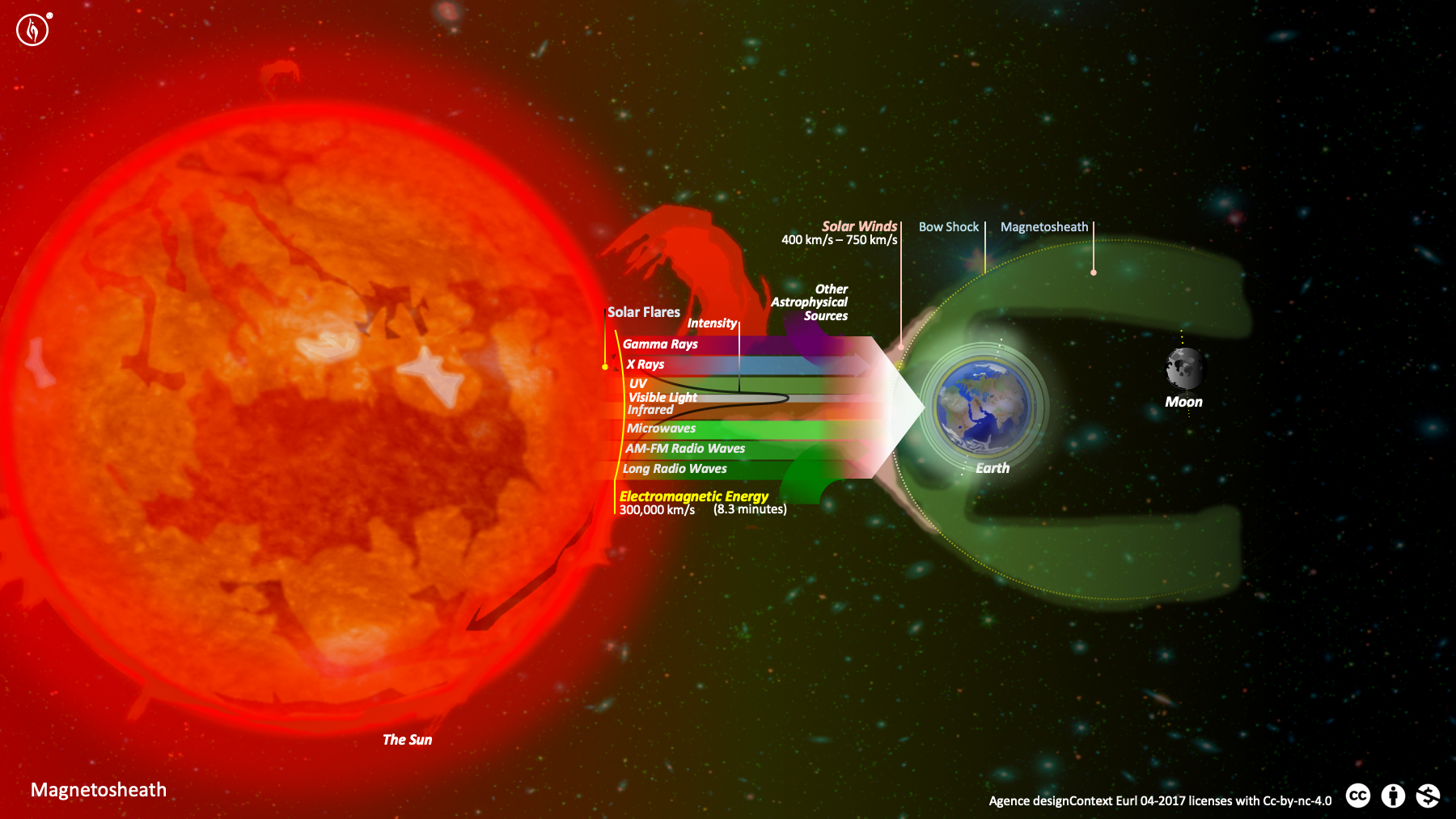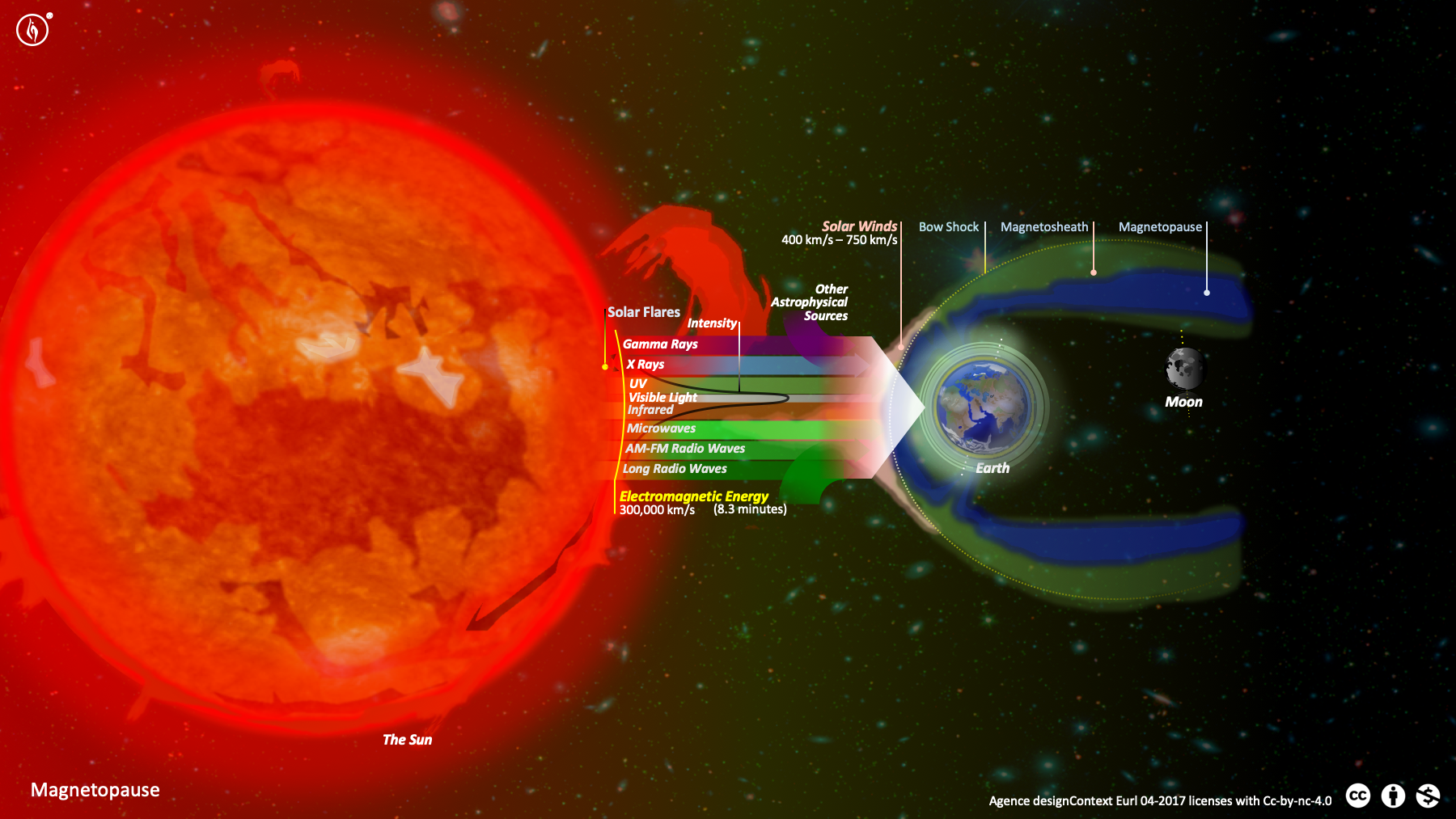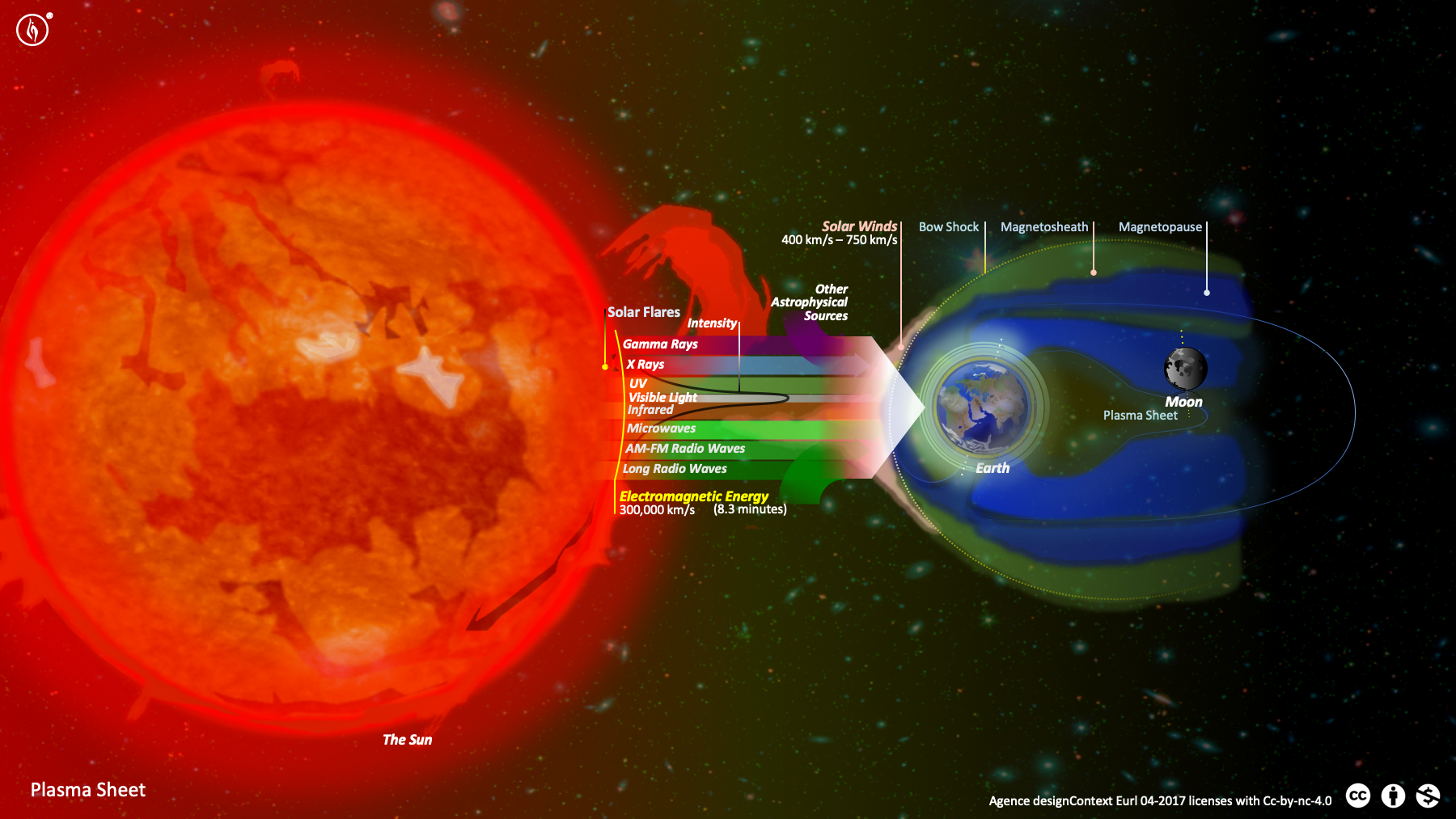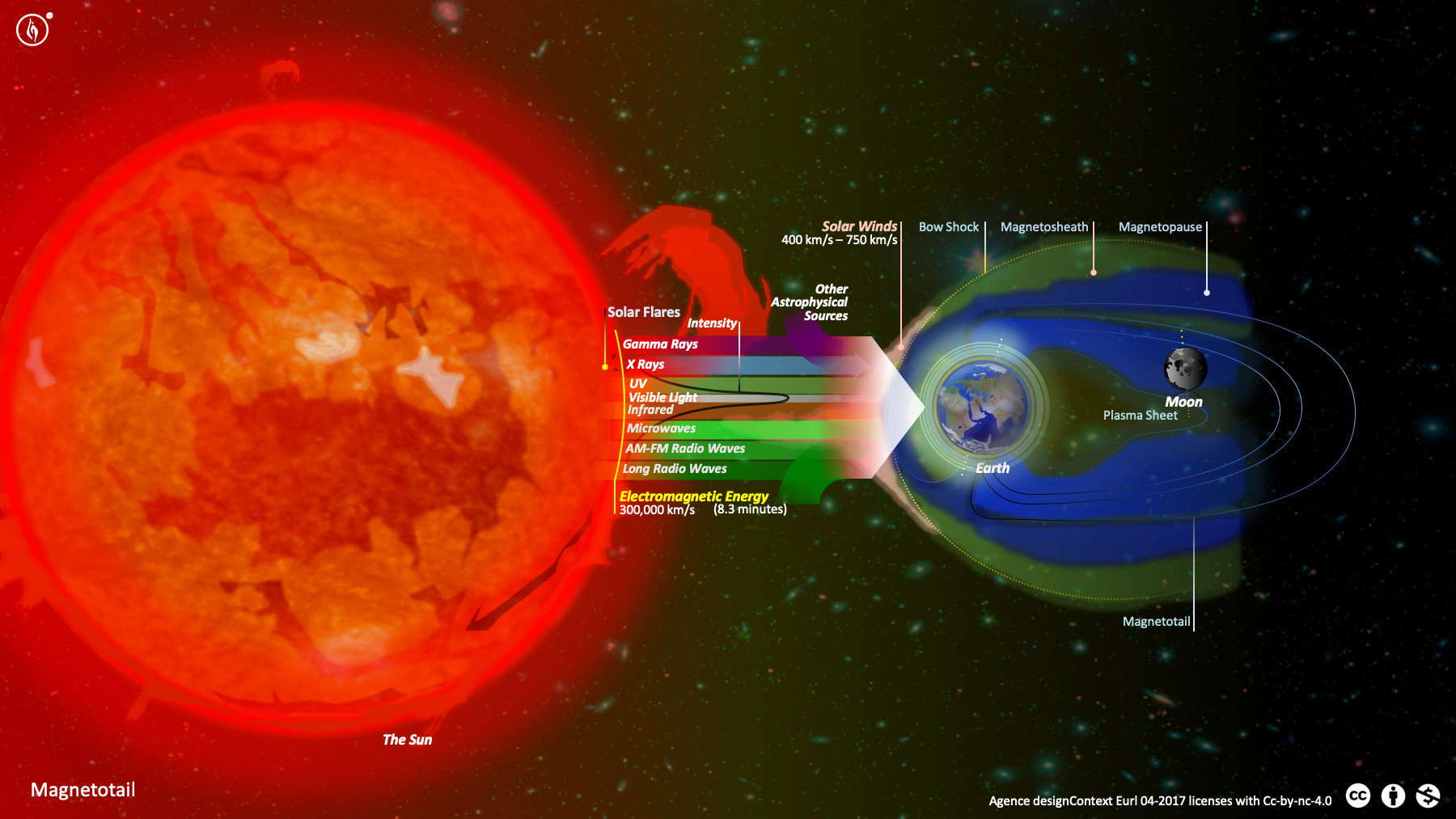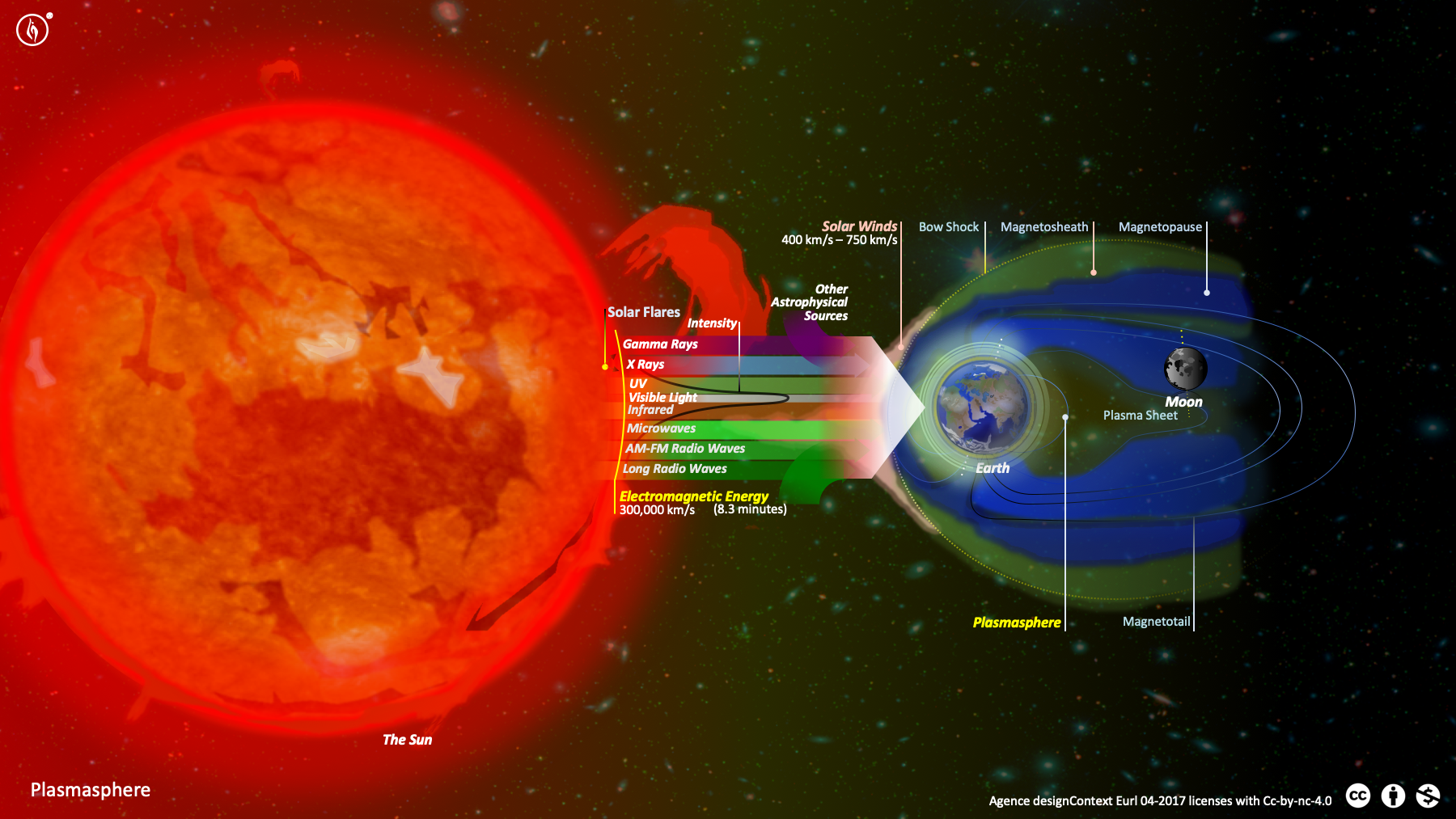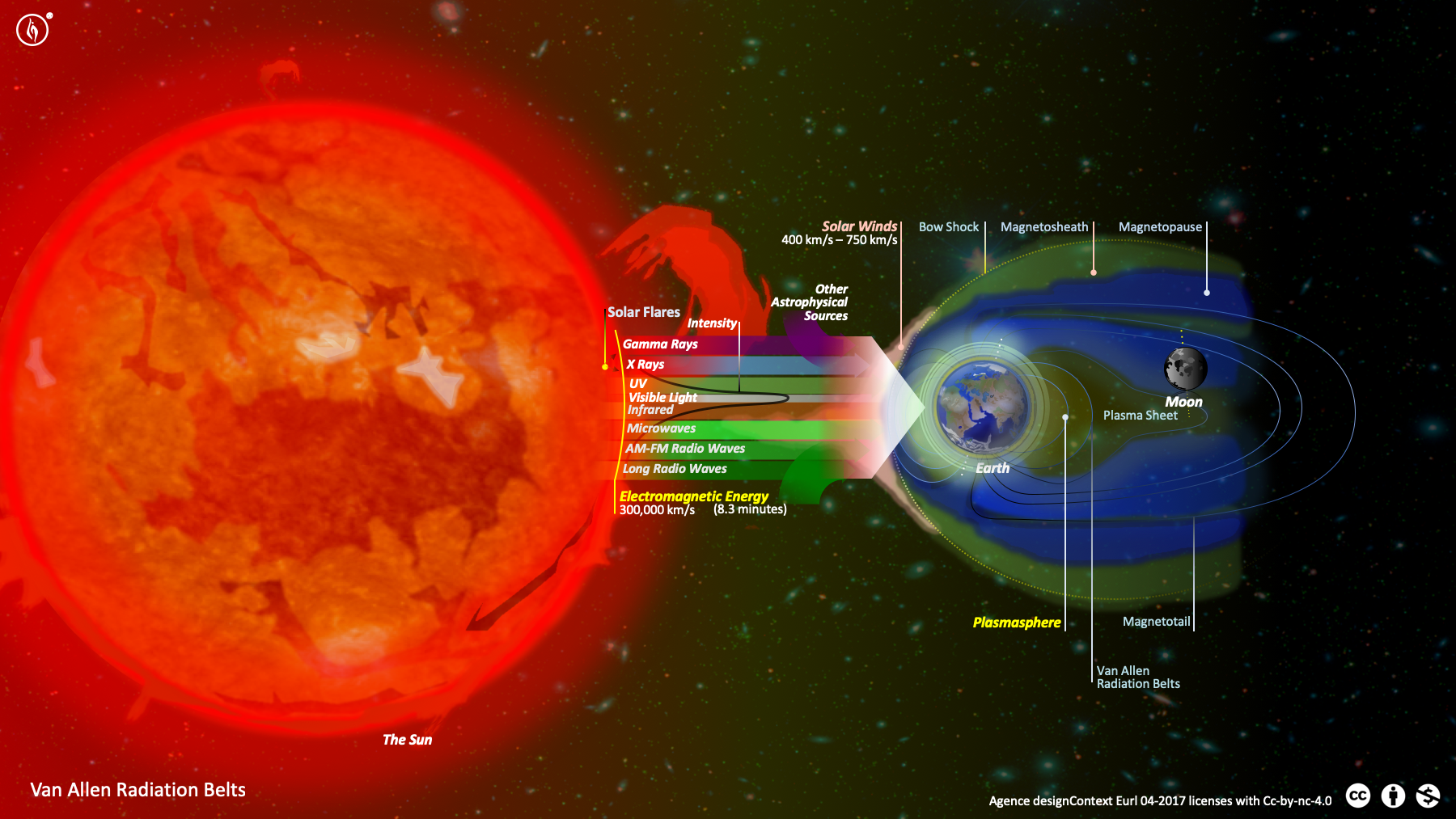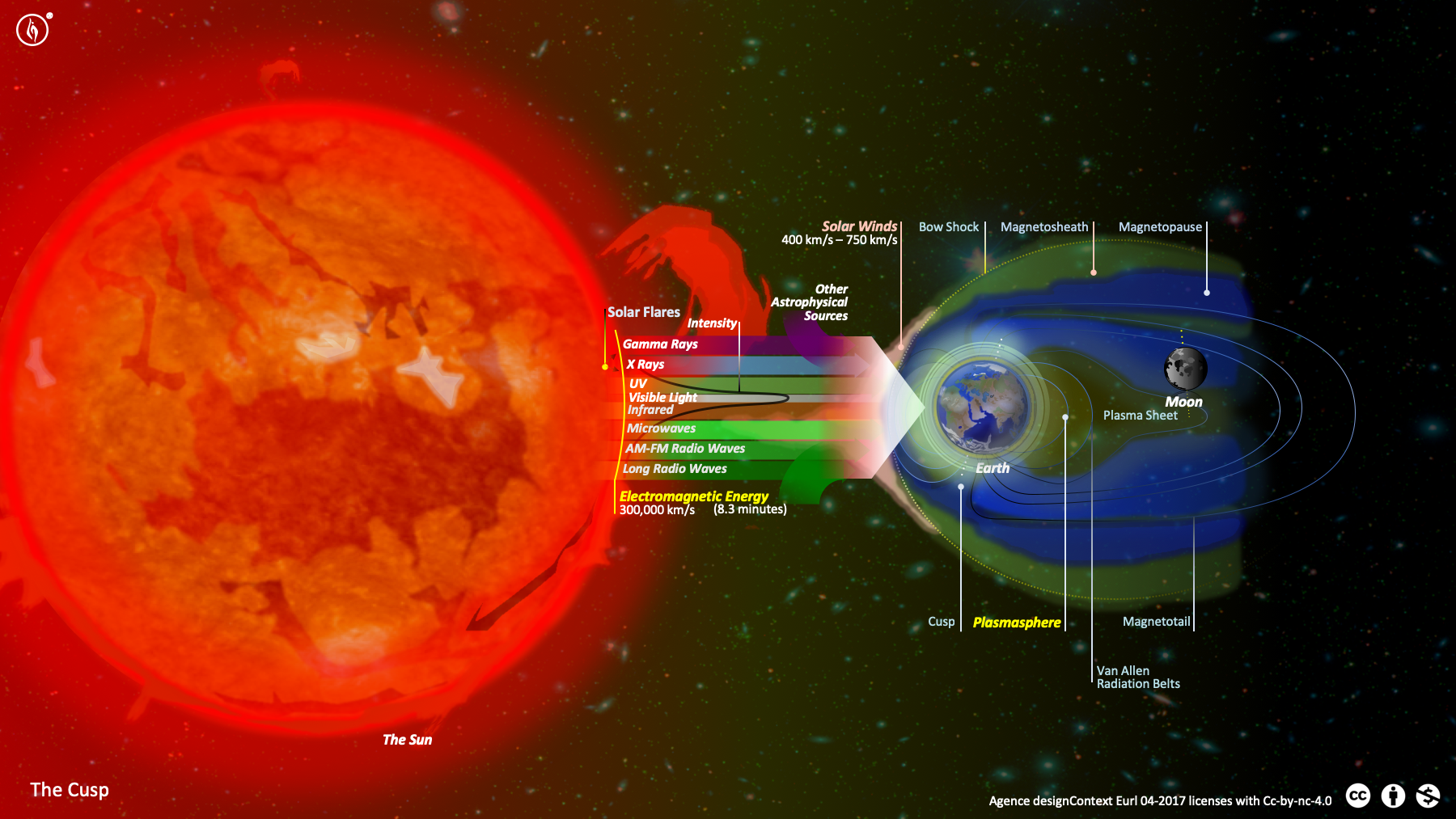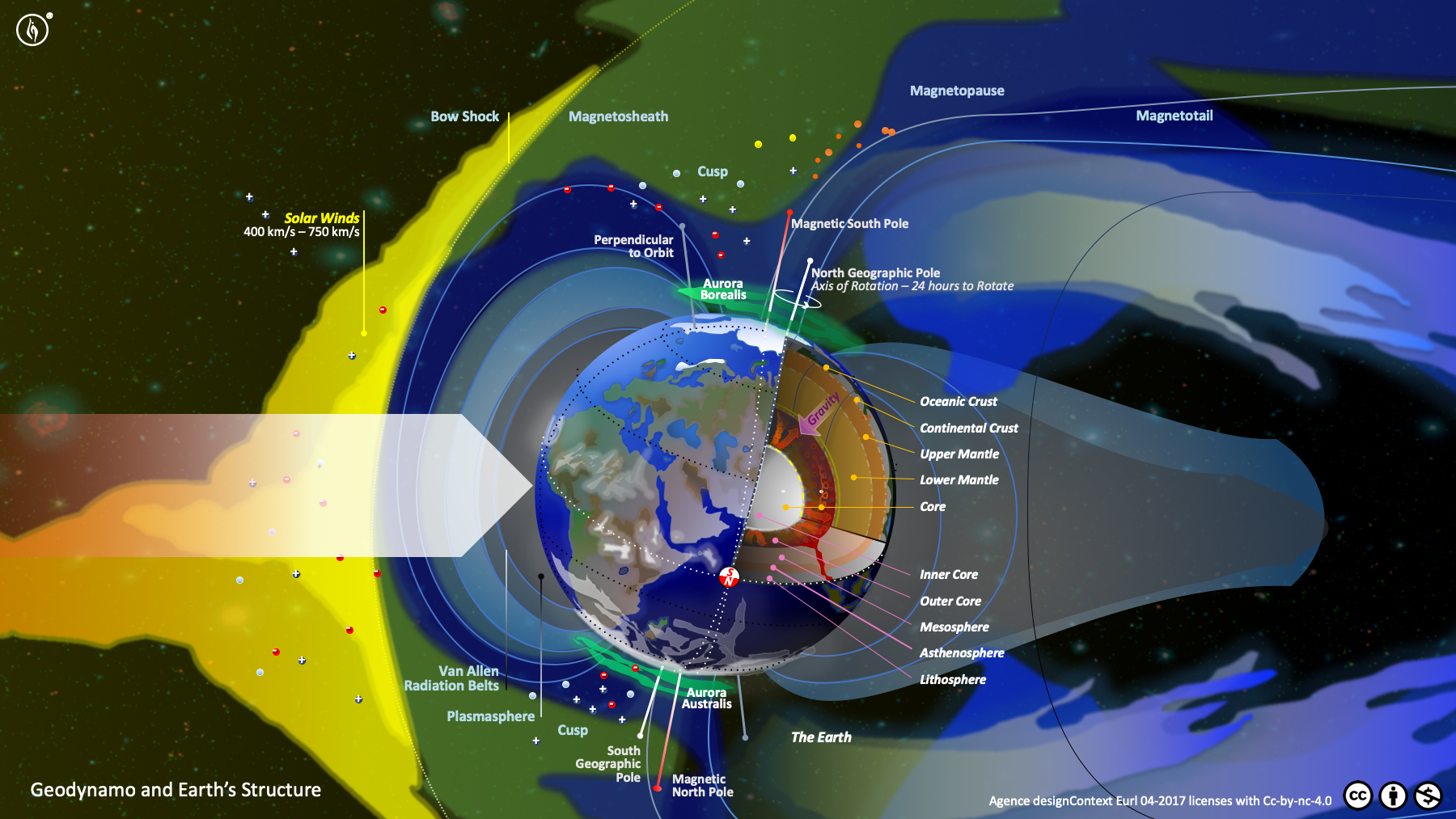El Campo de Fuerza Magnético
Esta es el área alrededor de la Tierra, que está dominada por el campo magnético de los planetas. Este campo protege la vida en la Tierra de la radiación solar y de otras partículas cósmicas, y de la erosión por el viento solar - el flujo constante de partículas cargadas que fluyen del Sol - que de otra manera destruirían la atmósfera superior de la Tierra, incluyendo la capa de ozono.
Se cree que es generado por el movimiento convectivo de hierro fundido cargado, que existe dentro del núcleo externo de la Tierra. Su forma está definida por el constante bombardeo de los vientos solares desde el lado que mira al Sol (el "lado del día"). El "lado de la noche" se extiende en una larga cola, mucho más allá de la luna. La magnetosfera es un sistema dinámico e interconectado que responde al Sol, al flujo planetario e interestelar.


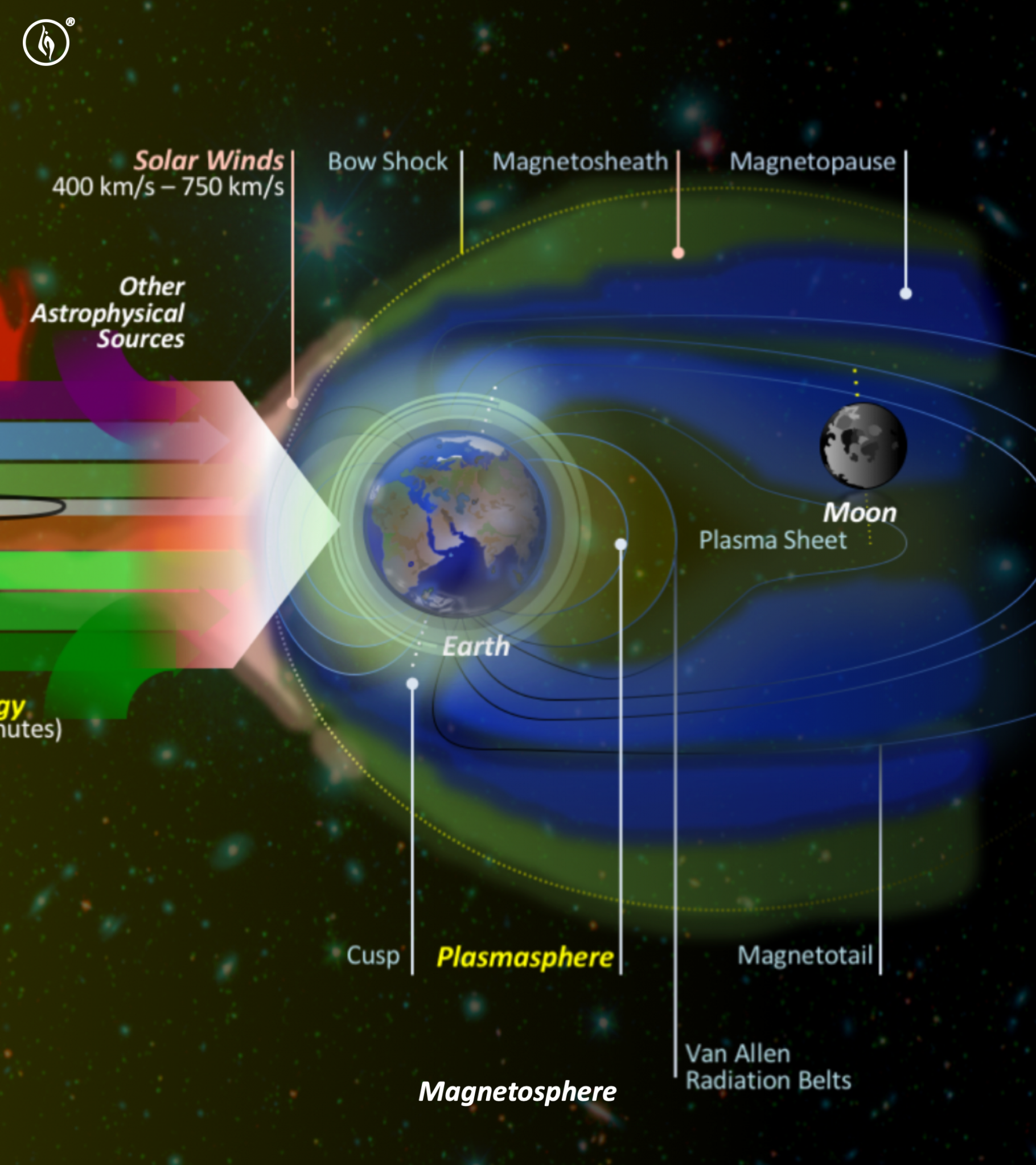
The Magnetosphere's Different Elements
Solar Winds and the Bow Shock
Solar winds are made up of streams of charged particles, which are released from the upper atmosphere of the Sun. The winds are a plasma - a soup of disconnected protons, and electrons and other particles - that varies in temperature, direction, and density over time. As the solar winds blow from the Sun, travelling at speeds of 400 to 750 km/s, and they encounter the Earth's magnetic field, where they are heated and slowed. Most, are then deflected around the Earth into the Magnetosheath, forming a bow-shape, much like water is deflected around the bow of a ship, compressing the day-side of the magnetosphere, and drawn out in a long wake on the night-side. The bow shock is estimated to be around 17 kilometres thick, and situated about 90,000 km from Earth.
Magnetosheath
This is the region inside the bow shock, the zone of 'shocked' solar wind, where Earth's magnetic field changes erratically. Some particles from the solar winds are able to enter this region, but are at a far lower density than outside the bow shock.
Magnetopause
This region below the magnetosheath, is classified as the abrupt boundary between the solar wind, and the Earth's magnetic field. The magnetopause contracts inwards and expands outwards in relation to the solar winds changes in pressure.
Plasma Sheet
Some of the solar winds that are able to enter into the magnetosphere, form the plasma sheet. A sheet of hot and charged plasma that extends out into the magnetotail, dividing the north and south 'lobes.'
Magnetotail
Despite its' name, as mentioned previously, the Magnetosphere is not a sphere in the spherical sense. The magnetotail is the resulting asymmetric form, generated on the 'downwind' side (or night-side) of the solar winds. The magnetotail extends far beyond the orbit of the moon, and so once a month, for around 6 days, the moon enters the Earth's magnetotail. During the crossing, the plasma sheet, which amongst other particles, contains electrons, gives the moon a negative charge - particularly on the nightside - and is thought to create dust-storms due to an increase in surface voltage. Many of the solar wind particles that have been deflected around the Earth via the bow shock can enter back, into the magnetotail, and stream towards the Earth's magnetic poles. As explained by Brian Cox (2010):
“...when the solar wind hits the Earth's magnetic field, it distorts it. It stretches the field out on the night side of the planet... More and more energy goes into the field and over time this energy builds up, stretching the tail until it can no longer hold on to it all. Eventually the energy is released, accelerating a stream of electrically charged particles down the magnetic field lines towards the poles.” [1]
Plasmasphere
This region, contains relatively low energy, cooler, and denser plasma, and is situated above the ionosphere. The plasmasphere is trapped within magnetic field lines, creating an inner 'donut' shaped region, that rotates with the Earth. It is basically an extension of the ionosphere below, and is composed of mainly H+ (hydrogen ions), and a lower amount of ionised helium (less than 20%), flowing out of the ionosphere below.
Van Allen Radiation Belts
These are the zones where solar winds have been captured and held around the Earth. The energetically charged particles create two donut shaped belts - the inner and outer radiation belts. This charged zone deflects further solar winds from entering the Earth's atmosphere. The charged particles are mainly electrons and protons.
The Cusp
The Cusp is the 'open area' between the plasmasphere and radiation belts, where magnetosheath plasma can enter the most directly into the Earth's upper atmosphere. Excited solar wind particles enter through the Earth's magnetosphere somewhere on the frontside (day-side), or, as previously mentioned, back in from the night-side via the magnetotail, and then follow the geomagnetic field lines, which converge to a relatively small area in the high-latitude ionosphere.
References
[1] Cox, Brian and Andrew Cohen. (2010) 'The Wonders of the Solar System.' Harper Collins Publishers, London, U.K.

Light Shows and Dynamos
Auroras
Aurora Borealis in the Artic (northern lights), and the Aurora Australis in the Antarctic (southern lights). Auroras are produced when solar explosions, known as coronal mass ejection, generate highly charged particles, that flow within the solar winds. These are able to disturb the Earth's magnetosphere sufficiently to enter into the lower regions of the atmosphere, by flowing down the magnetic field lines at the north and south magnetic poles. Within the atmosphere, the solar particles and the disturbed magnetic fields release particles already trapped near earth within the Radiation Belts, which triggers the reactions with gases such as Oxygen (O2 and O) and Nitrogen (N2). Once these charged (excited) gases return to their normal, lower energy state, they give off light (photons), which is the oval band that can be seen from Earth and from Space; Green (high energy) and red (lower energy) light from Oxygen, and blue and purple from Nitrogen. The Auroras also have an effect on the ionosphere, within the Earth's atmosphere.
Earth's Geodynamo Theory
It is thought that the Earth has at its' centre, an inner core, a solid mass roughly the size of the moon, which is mostly composed of iron (Fe) and some other elements such as Nickel (Ni), and it's temperature is similar to that of the surface of the Sun. Surrounding the inner core, is the outer-core, that is also believed to be of a similar composition, but is a rotating fluid (rotating due to the rotation of the Earth - the coriolis effect), which moves in spiral currents, across weak magnetic fields, creating an electric current (the dynamo effect). The spiralling of the currents is thought to be driven by convection, where hot, buoyant iron in the lower areas of the outer core (heated by latent heat released by the expanding and cooling inner core), float up to the surface (like a lava lamp), where they cool and therefore get denser, and sink down again. This continuous convection process, also releases heat from the core, into the mantel, which helps drive plate-tectonics.
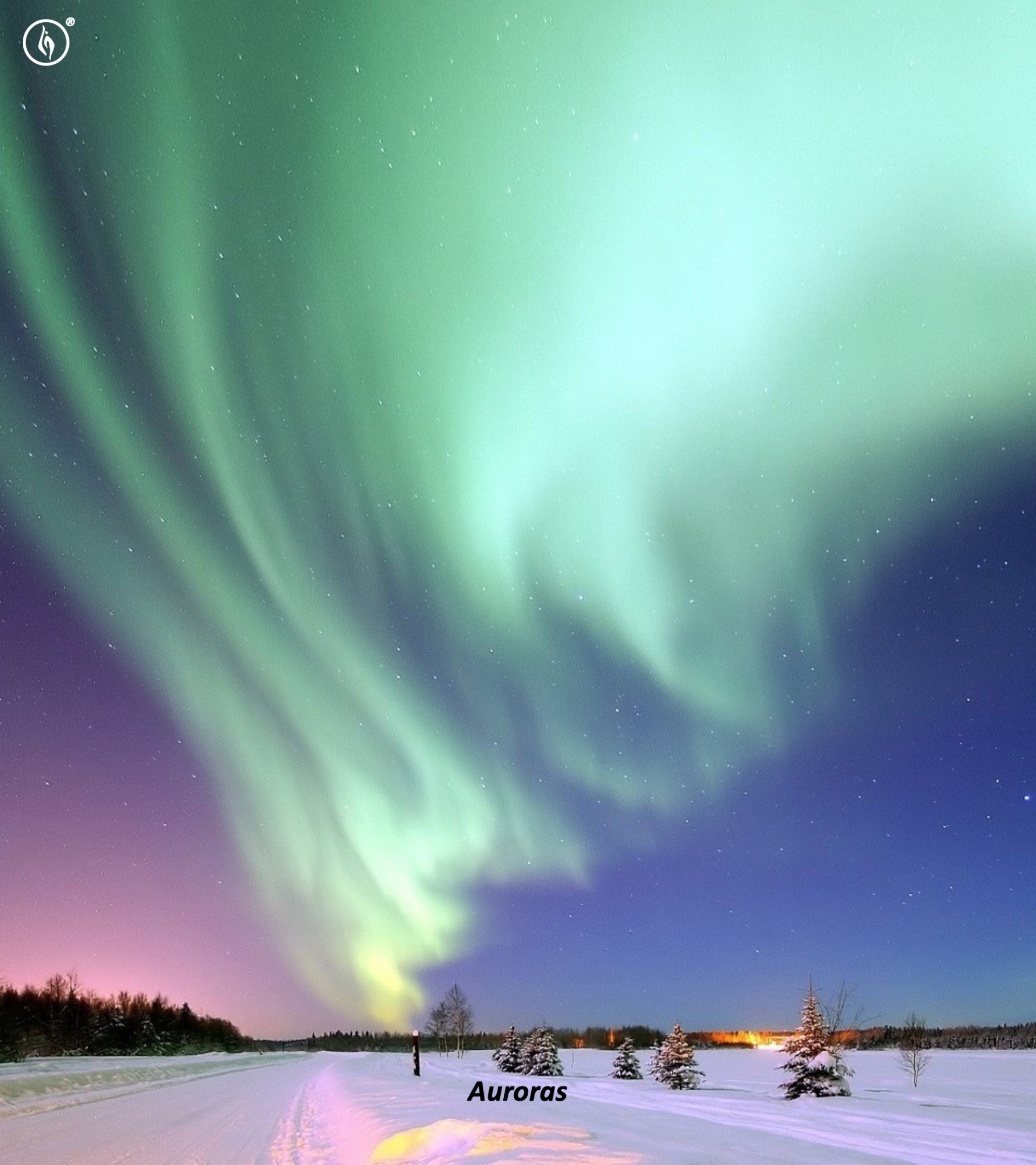



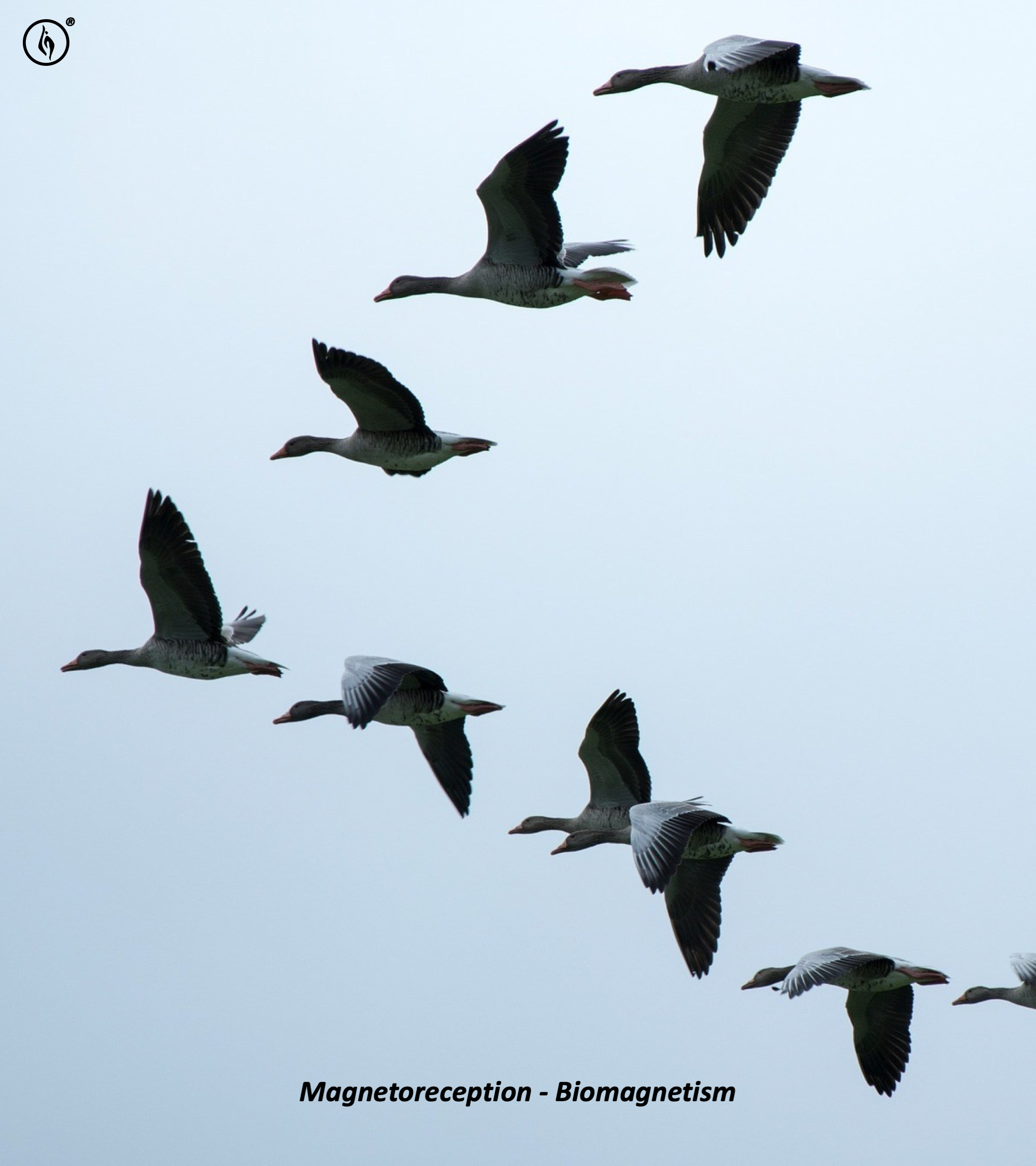
Finding Our Way
Earth's Magnetic Poles
The variation between magnetic north (Nm) and "true" north (Ng) is around 11°. "True" North is the north of Earth's rotational axis, and the North geomagnetic pole, which is in fact the south pole of Earth's magnetic field, is located near Greenland in the northern hemisphere.
Earth's magnetic field polarity changes overtime, driven by changes in the Earth's crust - the geodynamo of iron alloys, and is recorded in certain rocks, particularly the spreading mid-ocean ridges. This switching of polarity can happen rapidly, although between periods of a few thousand years. The two magnetic poles can also wonder independently, with movements up to 40km; however these movements are generally slow, and make compass navigation viable.
Magnetoreception - Biomagnetism
Magnetoreception is a sense an organism has that allows the detection of a magnetic field. This can aid in the perception of altitude, location, or direction - which is particularly useful for migration. Many forms of life have been discovered that have the ability, however the actual sensory receptor is often difficult to locate. Examples, include some invertebrates, such as nematodes and earth worms, honey bees, ants and terminates; some birds, such as homing pigeons, European robins, and chickens; some mammals, such as rodents, and potentially roe deer and even cows; and some bacteria, such as the aptly named 'magnetotactic' bacteria. Although yet to be proven, we may also have magneto-receptors in us.


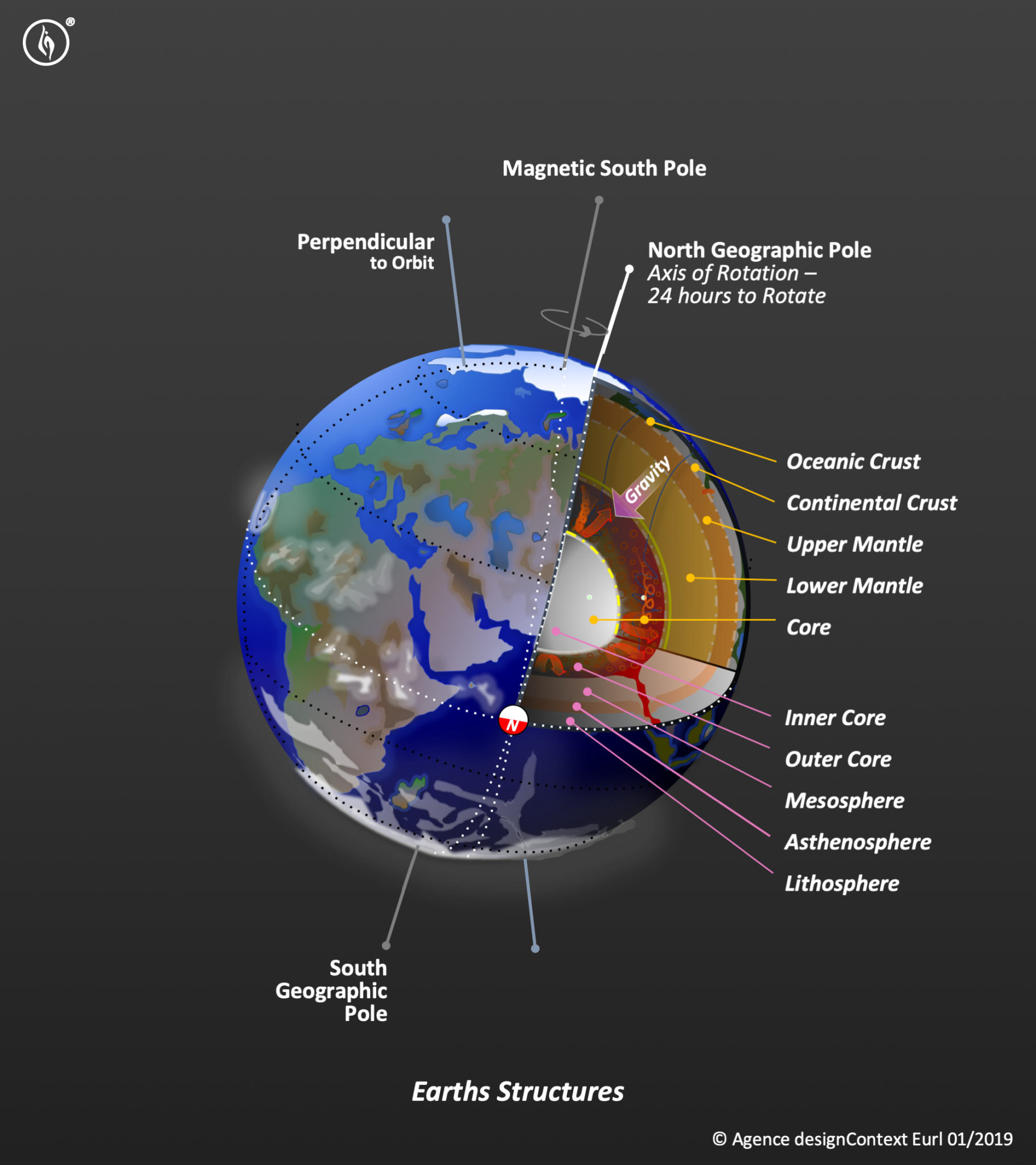
Structures of the Earth
The dynamics of the structure of the Earth, linked to plate-tectonicswill be discussed in a page to come: this is a brief overview of the main structures in the Earth.
The structure of the Earth can be described chemically (separating layers that have different chemical compositions), or mechanically (separating layers that have different physical properties - i.e., solid, or liquid).
The chemical way to describe the Earth’s Structure, starts with the outermost layer - the Crust. It is the thinest layer, and there are two main types: Continental Crust, and Oceanic Crust. The Continental Crust (land), is thick (about 30-60km), relatively light, and is mainly granite. And the Oceanic Crust (the rock under the worlds oceans) is thinner (about 5-10km), heavier, and is mainly basalt. Both float on the layer below, the silicate Mantle, which is about 2900km thick, and below this is the Earth’s Core (as mentioned above is mostly iron). In general, during the development of the early Earth, the densest elements sunk to the centre (the core), and the lighter elements and gases bubbled up to the surface, and some out into the atmosphere.
The mechanical description, combines the crust and the coolest mantle layer, and is called the lithosphere (10-200km thick - although closer to the higher thickness). It is rigid, cool and brittle. The layer below is not a liquid, but is more liquid (plastic) than the layer above, due to the higher temperature, and in terms of the mantle, is still within it (going down to around 660km), and is called asthenosphere. The next lower layer has pressures and temperatures so high, it is rigid, and is called the mesosphere(ending at the bottom of the mantle - so 2900km depth). The core is divided into two layers, the Outer Core, which is liquid (around 5100km deep), and the Inner Core, which is solid.


